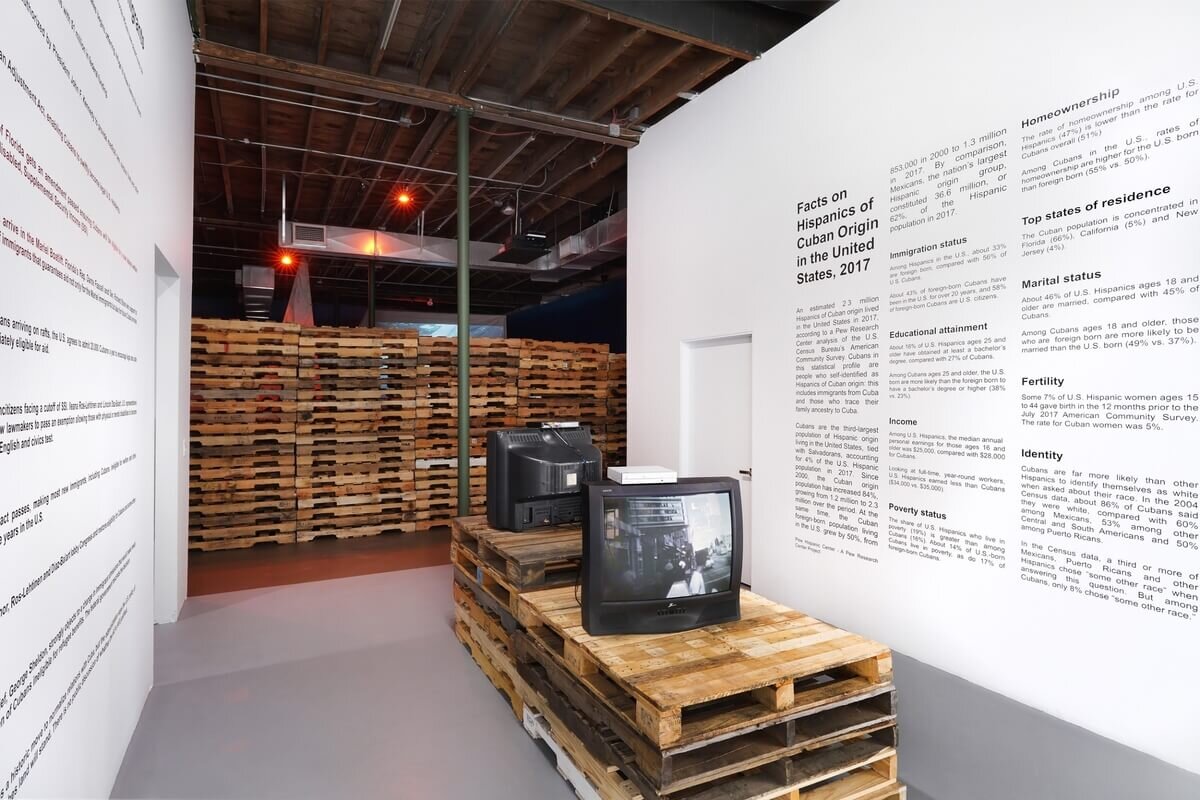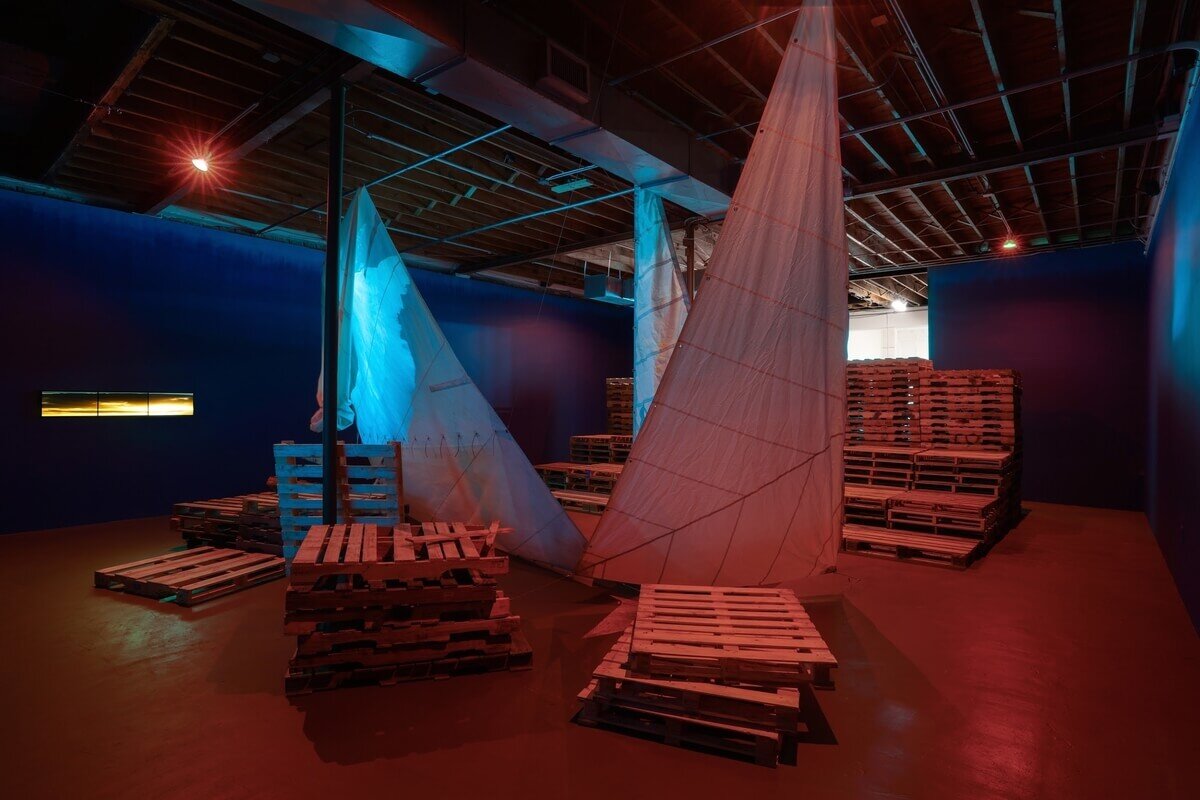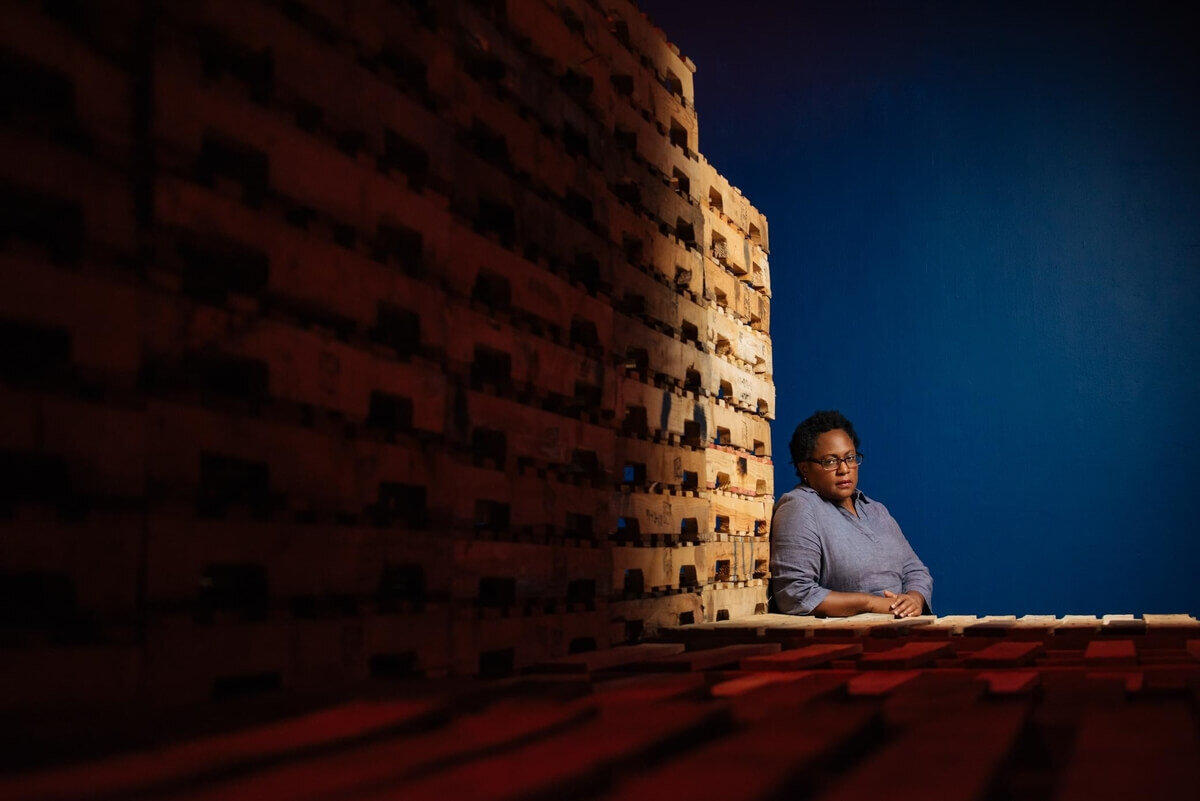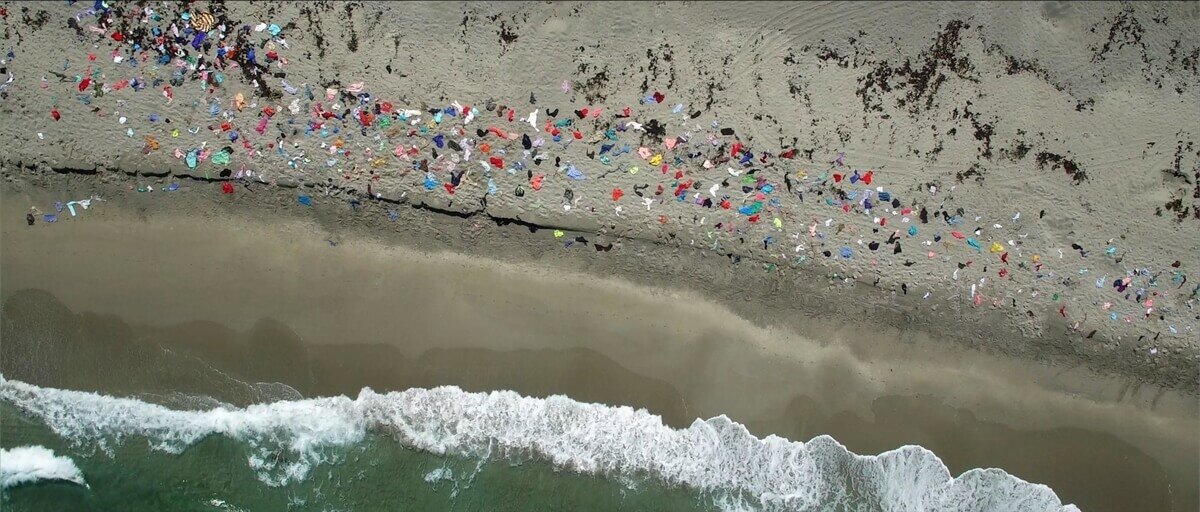Months long conversations with artist Juana Valdes culminated in an exhibition review of her ambitious show Rest Ashore installed at Locust Projects Miami in anticipation of the 2020 US presidential election. Latinx Spaces offered a platform for my thoughts and hope for a more nuanced depiction of BIPOC Caribbean Latinx in the US. Juana is magnanimously optimistic artist, so conversing with her in the wake of my own covid canceled solo show provided solace and solidarity. Full article with installation video and images available here:
https://www.latinxspaces.com/latinx-art/artist-juana-valdes-offers-refuge-in-rest-ashore
Exhibition Review pdf download
ARTIST JUANA VALDES OFFERS REFUGE IN ‘REST ASHORE’
Rest Ashore, 2020 4K video, 12 min.
By Coralina Rodriguez Meyer
Sinking American Dreams seek refuge in Juana Valdes’ Rest Ashore multimedia installation in Wynwood at Locust Projects. Reflecting on the US election and forecasting a shift in governmental policies for the Latinx community in 2021, Valdes’ online show represents a timeless odyssey of Latinx movement between political refuse and material refuge as told through the Cuban American experience in Miami. An ambitious installation inside the nonprofit gallery space, the installation was physically open to the public from September 12 to October 24, 2020 during a conservative surge for the Miami Cuban electorate outside the gallery walls. A glimmer of hope in an art and electoral expansewhere Afro-Cuban women’s voices are seldom heard; Valdes’ ambitious ouvre can’t be ignored by the canon during such a pivotal time in our nation’s history. Representing a timeless odyssey of Latinx movement between political refuse and material refuge—the immersive exhibition is a culmination of the artist’s career and her visionary work to date. While American democracy drowns in political uncertainty, the artist’s career swells.
Juana Valdes’ show is as influential to American art history as the mythological masterpiece of American Fiction, Benito Cereno. Her visionary complexity defines our political state: not within the constraints of news fiction/fact, or aesthetic privilege—but by depicting the limits of our political imagination. Like the narrator in Benito Cereno who fails to differentiate between savagery and humanity because of his failure to consider the Spanish characteristics of the protagonists; the viewer of the exhibition must recalibrate their judgement to see the full impact of this magnanimous show.
The viewer in the exhibition is placed on a critical voyage upon entering the work, and is pulled around the gallery in a centripetal force towards the equatorial line between rest and action. The body’s movement through the installation is as structured by the calculations between the stadium, sails and screens as by the bureaucracy an immigrant must maneuver upon our port of entry. References ranging from Pepon Osorio’s rigorous video sculpture installations are cast in the exhibition against the minimalist levity of Hans Haacke’s sails and possibly IBeam Design’s refugee shelter Pallet House. Valdes steers the viewer instead, towards a more immersive and mythological framework in this determined installation. I am navigated as much by the complexity of the art and narrative historical path embedded in the exhibition’s interior, as by the frothy election news cum telenovela atmosphere outside.
Advertisement
Taut throughout the show is the line between news facts and allegorical fiction. Both are mastheads loosening or causing friction as my body moves through Valdes’ space. The Benito Cerreno phantom wafts through the ghostly projections of missing bodies from garments that hover over wave swells and confetti the shoreline. America from the show’s viewpoint, fails to destigmatize and transcend racial, gender, class (or any other intersectional hierarchies). Valdes suggests in this littoral exhibition that when the skeletal remains of our tattered democratic ghost are revealed; judgement will be issued not by the decayed institution, but cast away by our littered constitution.
Juana Valdes’ heroic transformation of the traditional white box confronts the ballot box and its own complexities beyond our nation’s media wall. Impossible to ignore in the 2020 US, are those who maintain the world outside our quarantine screens and compose our nation’s largest marginalized population: the Latinx vote. Broadening our perspective and understanding of the Latinx community’s conservative tendencies, the exhibition examines racial, status and class hierarchies deeply embedded within American culture from both an Anglo and Latin, qualitative and quantitative perspective.
The use of didactic statistics on the exhibition’s entry wall, paired with Cuban immigration news footage (in English and Spanish) is displayed on vintage televisions. Parchment gallery walls are forecasts for your path ahead. Their white, stiff sails glisten with black text that reads: “Facts on Hispanics of Cuban Origin in the United States 2017”. The immigrant population in the United States for example, has quadrupled since the 1960s though it has slowed down in recent years. It is projected to double by 2065, according to the Pew Foundation reaching a record 44.8 million in 2018. Complicating the news media’s oversimplification of the Balsero/a, Juana Valdes’ scientific narrative offers more to the viewer than a binary Latinx figure whose villainized image is stretched between fact and fiction.

Excerpt of Pew Research facts depicted in the installation’s wall text:
Registered voters who trace their origins to Cuba make up 6% of the Latino electorate. In the 2006 National Survey of Latinos, 28% of Cubans said they considered themselves Republicans, more than Mexicans, (15%) Puerto Ricans (11%) or Central and South Americans (7%).
About 20% of Cubans considered themselves Democrats, fewer than Puerto Ricans (50%) or Mexicans and Central and South Americans (29%). More than a quarter (27%) of Cubans considered themselves Independents, slightly higher than Mexicans (25%) and higher than Puerto Ricans (15%). Among Central and South Americans, 34% considered themselves Independents.
Embarking on the most ambitious installation and personal challenge of her career to date, Afro-Cuban artist Juana Valdes, like her community; survived the pandemic reflecting on intergenerational knowledge and community perseverance. Valdes balanced university teaching, caring for her mother and meditating on the increasing number of Latinx pandemic victims, while installing her robust multimedia installation Rest Ashore. Like most underrepresented Black, Indigenous, and People of color (BIPOC) Latinx, Valdes draws on her personal narrative to analyze America. Her show reflects on the history of her Cuban exile experience and chronicles it through the eyes of the news media in Miami with a massive installation of material mythology.
Unwaveringly bureaucratic and boldly didactic, the political timeline sourced from Pew Foundation’s research about her Cuban community’s presence in the US frames the artist’s immersive multimedia installation ahead. Awash in the tunneling sound of a 45-minute video loop on CRT televisions; the lettered walls feedback soundwaves between Cuban migration footage (cut from the Lynn and Louis Wolfson the II Florida Moving Image Archives at Florida International University) and stacked shipping palettes whose clapboards are a pedestal for the Waves of Migrations (Olas de Migraciones) entry monument. Juxtaposed to the media footage of Cubans arriving in rafts, boats, cargo ships and planes the show’s entry TVs and text details 50 years of immigration and government assistance for the Cuban community in Miami.
The bold gesture introduces the viewer to a pedagogical approach to art making and its intellectual conflict with media marketing. The contrast of the massive dry text on white walls against the looming black box theatre beyond, signals other language conflicts within the Latinx community and their visual, verbal or physical virtues. Verbally, the use of the term “Latinx” for example, is astorn as the nation’s Latin American electorate who resists assimilation and commodification into a broader US monoculture. According to Pew, most Latin Americans in the US do not use the Latinx term to self-identify, though many academics and younger generations use Latin”X” as a gender fluid alternative that the original Spanish male/ female binary “Latino/a” suggests.
Advertisement
While language remains a broken compass for US based Latin Americans, representational politics are equally unstable during the US presidential and senate inaugurations. The exhibition’s site—as well as its author—provide a contextual bearing for the viewer’s full immersion aesthetic language program. Visually, Cuban subjects appear on the gallery’s television screens as news backdrops and on the white walls as black text blocks. “Balseros/as” (Rafters as they are called by the newscaster) function as hyperbolized text or in today’s social media standards: less than 280 characters. The didactic Helvetica font style outlining PEW statistics are dizzyingly lettered on double height whitewalls. It’s scale reads the way an upside down exclamation ¡point!, or an Ñ as in CÑN may strike a double consciousness blow to the non-fluent viewer.
Physically, the body’s movement and eyes scroll through the show on rhythmic waves of emotional insecurity. Pacing from outside the gallery to inside, the overall path leads to the depths of the exhibition’s dark center and back. Outside, the Afro-Cuban Latinos for Trump (and Proud Boys) leader shouts from the El Nuevo Sol radio station on the calamitous calle. The viewer takes momentary refuge inside the gallery as the silence of this cardinal white space with museum scale text aligns the Zenith TVs not on pedestals—but on shipping palettes. Cold walls are unsettling until you see a dark room beyond whose warm, cutting glow builds curiosity through a wall of wood pallets stacked like a ship deck slats.

The black and white entry TVs tunnel the viewer’s expectations into periscopic attention towards the main installation. The news footage is both a narrative antecedent and technological ancestor to my short attention span. My scrolling gaze shifts towards the horizon of the video projection chantry of the installation. Interrupted by saline light slicing through ship clapboards, an otherwise molasses haze billows evenly through a black box theatre whose wall of shipping palettes bar my entry to the show.
I pivot my body sideways to the right, uncomfortably choosing a narrow Northward entry to what becomes an immersive installation of stadium seating (also made from shipping palettes). Boat-sized video projections on delicate sails, curve gingerly while their reflected light waves against the splintered corners of heaved palettes. Flatscreens on cobalt perimeter walls serve as a Third horizon for the installation on the Western-most wall of the gallery. Depicted on the double-wide screen, a “Balsero, Marielito” or “Gusano” (as he was called by the earlier installation’s press footage) paces along indecisively across a littoral landscape.
A choice must be made by the silent character whose bare feet carry traces of sand leaving behind textured imprints that mimic jetty stones and the ocean current beyond. Contrasting his heavy mind, the protean figure casts his gaze beyond the crashing waves to the sea: where he and the gallery goer imagine a visual terminus. Instead I pivot back towards the glow of the central installation, allured by the rhythmic light being projected not only through a lens, but through the ocean’s meniscus beneath the waves.

To contextualize the show within the current political climate for Latinx people, one must consider the site, sight and sounds of the exhibition. The work in the show echoes election media of both the past and future: whether current conservative party ads blasting on car radios outside the gallery in Miami coming from El Nuevo Sol (local Spanish language radio station) or the ubiquitous pulp propaganda ads inside the Tropical grocery store circulars. The exhibition footage asserts that the usual waves of migration hysteria, paranoia and nostalgia must be considered like any other visual or verbal political threat. A characteristic of the standard, histrionic election reporting is the pernicious replay of the label: “incalculable” Latinx. As though both parties equally fail to see or encapsulate Latinx people. There is an underrepresented and mischaracterized depiction of Latinx in American media. Quietly on the left, brilliant creative Latinx leaders like Juana Valdes are ignored by the canon. Trumpeted by both sides of mainstream news however, is the neo-fascist Afro-Cuban Proud Boy/Latinos for Trump chairman whose double-speak tornado is invited to man-spread across our screens.
In today’s capital political climate however, it is the fear of democracy itself that reigns tyrannically and technocratically. The growing white-supremacist fear inside the Latinx community, warns that a transfer to blue wave power could reflect the rhythmic drumbeat of socialism. This farce is nostalgically pounded out through attack ads and the colonization of our democracy. Most traumatizing to US based Latin Americans however, is the terrifying image of an overrun US capital reminiscent of violent dictatorial coups across the Americas: an image that generations of Latinx paid the price to escape. A nervous undercurrent blasts across the radio waves today, and on the black and white footage in the exhibition footage. The fiction specifically targets Cuban Americans, by claiming: if a democratic regime takes power, Cubans could lose their special immigration privileges.
‘Not True’ the exhibition argues in an exhaustively researched video, sculpture and text-based debate. Cuban immigration progress occurred more frequently under democratic presidents in the US, but will be infinitely overcast by the Kennedy Bay of Pigs shadow in American political aesthetics. In the show, we are reminded of this by RFK’s appearance in the CRT video loop. Pew’s research facts introducing the show set an unusual standard of fact-based, museum quality investigation in an exhibition for such a small gallery on the mainstream art world spectrum. Juana Valdes’ Rest Ashore is an enlightening protagonist in an otherwise romantic, machismo and racially volatile Southern, tropical political show.

The sagging state’s conservative baseline outside, and its coastline heaves and flexes inside the main installation’s video projection. Aerial coverage pans begin to feel like real estate drone footage—attempting to lure the viewer into a trancelike advertisement. Intercut with shots beneath the waves as the camera slowly drowns down under the scintillating waves, flecks of shells and clothes confetti begin to penetrate the shore shots. Clothes are the absence of bodies, and embody our memory; piled like the installation palettes into hordes of consumer waste. The girl’s garments are a video medusa. Both a deadly gaze, and a comfortable jellyfish billowing along the water’s edge. A cloud white floating dress leaves the viewer beneath to contemplate either empathy or their demise. The ethereal projection begs the question: Did the American Dream or American Exceptionalism ever exist? When and for whom? Or was it simply a figure of our imagination treading water?
Valdes’ own experience migrating to the US from Cuba at the age of 7, is masterfully erected in her decades long art practice excavating consumer and political memory of Americans in movement; through class, space, race and time. This exhibition is the North Star of her work to date. Her own navigation through the art system both professionally and economically; reflects the false bill of goods that American exceptionalism (as bought and sold by the American Dream) promises. The system erroneously suggests young tokenism and exceptionalism are the way out of poverty and violence that destroys (or empowers authoritarians) in Latinx BIPOC communities like Miami.
Advertisement
While her career has begun to take off recently, Juana Valdes’ struggle to launch such an ambitious show during uncertain times reflects where her career should be: in her words “7 years behind schedule” (if you are following the Allstars). Juana Valdes’ career and her exhibition reflects the persistence of cognitive dissonance at play in both the art system and the political world at large for BIPOC women. A show of this fortitude would normally be a crowning achievement in one’s career. Juana Valdes prominent feature in the Latinx Art bookas well as herAnonymous Was a Woman Award could be interpreted as a turning point in an art system whose exclusivity overlooks artists like her (artists of color).
Were she a white male artist for example, the award may reflect a market correction to compensate for her “constantly emerging, yet mid-career” status as the artist suggests. Instead, a system that marginalizes Black, Indigenous and Women* of Color (BIWOC) artists, has not yet offered reparations or rest on these shores. The fiction of “rugged individualism” or “creative genius” for Latinx people is given nuance by a view of both Valdes’ own career trajectory and her Rest Ashore exhibition. The drowning dream is virtue signaling ‘American exceptionalism’, a characteristic of our culture whose last act of despair floats to the surface in an otherwise inhumane sea.

ARTIST JUANA VALDES OFFERS REFUGE IN REST ASHORE LATINX ART MARCH 4, 2021 BY CORALINA RODRIGUEZ MEYER
https://www.latinxspaces.com/latinx-art/artist-juana-valdes-offers-refuge-in-rest-ashore






